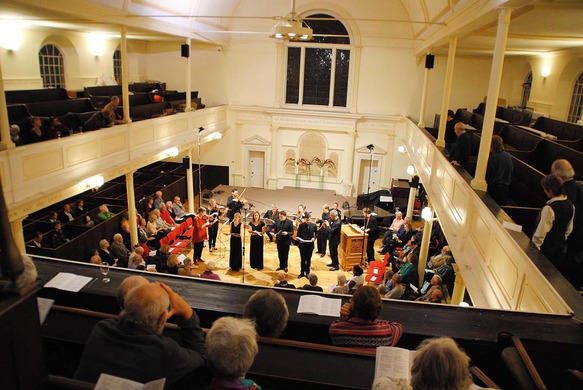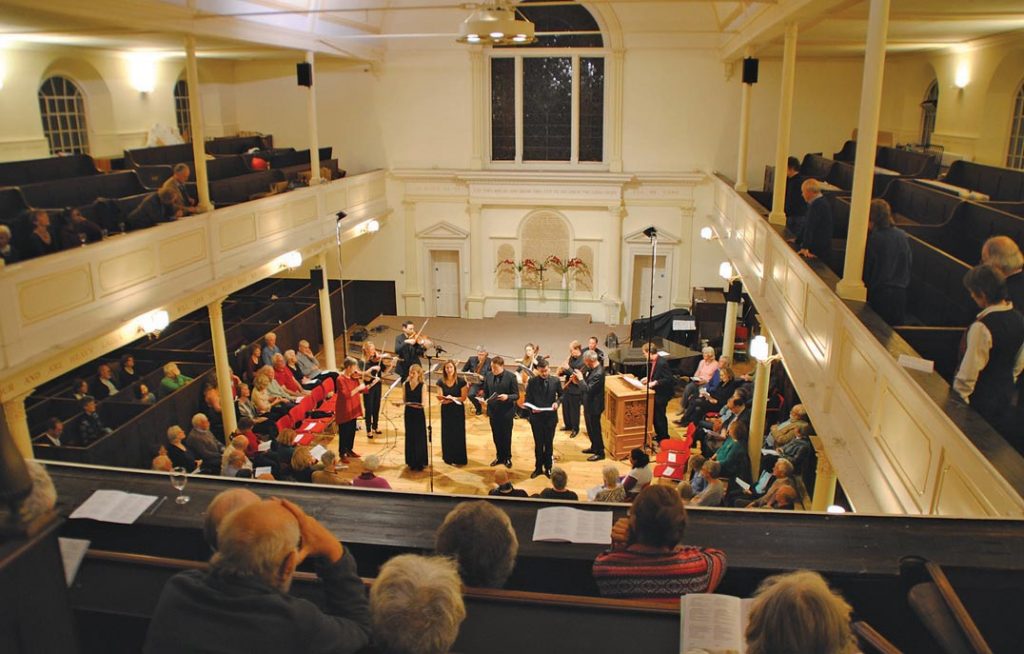Back to Journal
The Bach Players in north London: an anniversary retrospective

This article by Robin Kinross was published in September 2017 in the journal of the Highgate Literary & Scientific Institution.
Though the group has always been collaborative in nature, The Bach Players is very much the work of one person, Nicolette Moonen. After moving in 1992 to London from The Hague, she began to be dissatisfied with the limited opportunities for playing J.S. Bach’s music here. She had grown up in the rich culture of Early Music in the Netherlands, even sitting – as a child – at the feet of Gustav Leonhardt, the great harpsichordist, and a family friend. In particular she wanted to perform the church cantatas of Bach, which she felt were too little known in Britain. This was before Bach’s 250th anniversary celebrations in 2000, and notably John Eliot Gardiner’s Cantata Pilgrimage in which all the sacred cantatas were performed, and which helped to introduce this extraordinarily rich body of music to a wider audience in Britain. (Nicolette Moonen became a regular member of Gardiner’s orchestras then.)
So The Bach Players played their first concerts twenty years ago, in May 1997. The first venue in London was St John’s Wood Church. The late John Slater, its vicar, was happy to be the host and began to replace his Sunday evening services with these concerts of predominantly sacred music. Sealing the connection to the Dutch music scene, Gustav and Marie Leonhardt were patrons of the group, and – then as now – there was quite a high representation of continental European musicians in the group.
A local venue was an important part of Nicolette Moonen’s vision. The size and dispersed nature of London is both a strength (so much is happening on any one evening) and a source of frustration (one can’t go to everything!). Putting on your own concerts equally has its pleasures – you can play just the music you want, unbothered by an organiser or promoter saying ‘we would like this and not that’ – and also its difficulties (so much work in doing it all yourself!). But an audience began to form. Bach Players’ concerts are notably informal: audience members can sit in chairs arrayed around the musicians; children come free and can sit in the front row. This kind of occasion is a very natural, unforced way to break down the barriers that seem to restrict classical music – the raised stage, hushed silences, tie and tails and long evening dresses.
At that time Nicolette Moonen was living in Bounds Green and began to feel the difficulty of putting on concerts in another, unconnected part of London. The St John’s Wood series came to an end in 1999 (and two years later John Slater left that church). After the hectic year of 2000, the group re-emerged playing in other venues. Its focus began to broaden out from Bach, to include the music of his contemporaries, predecessors, and sometimes successors too. In December 2003, with a programme of Christmas music (Bach, Scarlatti, Corelli, Rosenmüller, Weckmann, Tunder), Nicolette Moonen says she got a taste for diversity and for finding threads and connections in programmes. A coherent programme that tells a story and provides variety would become a hallmark of The Bach Players.
The next steps in the group’s development came when Nicolette Moonen moved (in December 2005) to live in Dartmouth Park. After a concert in March 2004 she had met an audience member, attending for the first time and instantly converted to the Bach Players’ approach to performance: one player or voice to a part, without a conductor, and with a sense of common discovery among the musicians. He offered to help, at first with designing and typesetting the programmes. This person, I confess, is the author of this article, and is now married to Nicolette. In June 2006 they held a party for their marriage at the Highgate Literary & Scientific Institution.

Wishing to launch another regular series, the two of us thought about central London venues – a City church, for example. But one Sunday morning we walked across the Heath to St John’s Downshire Hill to see what this magical church was like inside. We knew of it as a music venue in the earlier days of the Early Music scene in this country. Inside we found it wonderful too: wooden floors, comfortable and moveable modern seating, a light and warm atmosphere, good facilities for an audience (since its restoration with a Heritage Lottery Fund grant). It also proved to have exceptionally good acoustics. We fell into conversation with Doug Mavay, then in charge of the church’s music, who loves Bach and was at once encouraging. The first concert at St John’s was given in September 2007, and since then the group has played there three times a year.
In recent years the concerts have come to have a pattern. In the spring, around Easter, the group plays sacred music, often on the theme of Mary at the Cross. In summer, a lighter, often secular programme is given: for example, music composed in the Restoration period for Shakespeare’s plays; or a programme of music about summer and the natural world. In autumn, there are cantatas by Bach and connected composers. French music – broadly, from Lully to Rameau – has become a strong interest. Too often overlooked in the British scene or dismissed as formulaic, it proves to be as rich as any nation’s music can be. And, for example, the impeccably ‘English’ Henry Purcell cannot be fully appreciated without knowing his debts to French composers. Nicolette’s mother was French and her maternal grandfather was a pioneering musicologist, Norbert Dufourcq. Perhaps it is in the blood.
Another step along the way came in 2009, when the first concert at The Octagon Chapel in Norwich was played. With the sponsorship of Aude Gotto, a local promoter, concerts in Norwich could be twinned with those in London.
With these concerts, the question of making recordings came up. Nowadays every group makes CDs. The rapid diminution of the old recording industry (especially since the rise of downloading and streaming) means that CDs have a special place – but musicians have to do it themselves. I am a book publisher with an imprint, Hyphen Press, and an office in Kentish Town. It seemed simple enough to start a label for music CDs: Hyphen Press Music became the group’s own label. Where to record? St John’s Downshire Hill suffers from daytime traffic noise. So we chose St Michael’s Highgate as our recording venue, for its great acoustic properties and friendly management. As with the concerts, we could do it just as we liked – microphones kept to a minimum, to allow the whole sound of the church to be captured.
After 12 CDs (the last to be issued this autumn), we have decided to bring the series to a close. Each of these CDs is based on a concert programme, and together they form an anthology of Baroque music – with J.S. Bach as the central presence, and exploring all the national and personal currents that flow through him and through European music of those times. A new recording project devoted to French composers is now under way for the German label Coviello.
The twenty years of The Bach Players is an example of a journey that wasn’t planned, but in retrospect it seems to make sense. Nicolette says that ‘The Bach Players has shown itself to me’. There are a few more years’ life yet in this group, and a few more unexpected turns in the road.
Robin Kinross
Highgate Literary & Scientific Institution Newsletter, no. 51, 2017, pp. 45–6